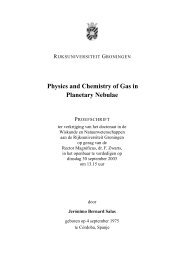TRACING ABUNDANCES IN GALAXIES WITH THE SPITZER ...
TRACING ABUNDANCES IN GALAXIES WITH THE SPITZER ...
TRACING ABUNDANCES IN GALAXIES WITH THE SPITZER ...
You also want an ePaper? Increase the reach of your titles
YUMPU automatically turns print PDFs into web optimized ePapers that Google loves.
II and Ib/c) supernovae (SNe) explosions. They produce the bulk of the oxygen,<br />
the principal element in the global abundance, as well as the bulk of other α-<br />
elements (such as argon, neon, and sulfur) which are formed by fusing together<br />
α particles (helium-4 nuclei, He +2 ) either in the core of the star or during the<br />
explosion (Matteucci, 2008). These supernova also produce other heavy elements<br />
through the r-process, the rapid capture of neutrons onto seed nuclei relative to<br />
the timescale of β decay (Woosley et al., 1994). Such massive stars have short<br />
lifetimes in the range of 1 to 10 Myr.<br />
Type Ia SNe caused by exploding white dwarfs in binary systems produce<br />
most (∼70%) of the iron and small amounts of other heavy elements (Matteucci &<br />
Greggio, 1986). Because the progenitors of these Type Ia SNe are low-intermediate<br />
mass stars, they have long lifetimes of several 10 Myr to over 10 Gyr. These low<br />
mass stars live longer than the massive stars which produce oxygen and other α-<br />
elements, and thus there is a delay between the iron and α-element enrichment of<br />
the ISM for a group of stars which formed at the same time. Thus the abundance<br />
ratio of α-elements to iron [α/Fe] can serve as a ‘cosmic clock’.<br />
Low and intermediate mass stars with masses in the range ∼0.8 to ∼8 M⊙<br />
ignite helium in their core and dredge-up episodes occur which bring the processed<br />
material from the core to the surface. The stars then eject some of their material in<br />
stellar winds during the Red Giant Branch (RGB) and Asymptotic Giant Branch<br />
(AGB) phases (Iben & Renzini, 1983). Radiation from the central star ionizes<br />
this ejected material which then “lights up” during a planetary nebula (PN) phase<br />
before the star ends its life as a carbon-oxygen white dwarf. In this way the<br />
stars restore part of their processed and unprocessed material to the interstellar<br />
medium, enriching the interstellar medium in helium, carbon, nitrogen, and the<br />
heavy s-process elements which are made by the slow capture of neutrons onto<br />
3













